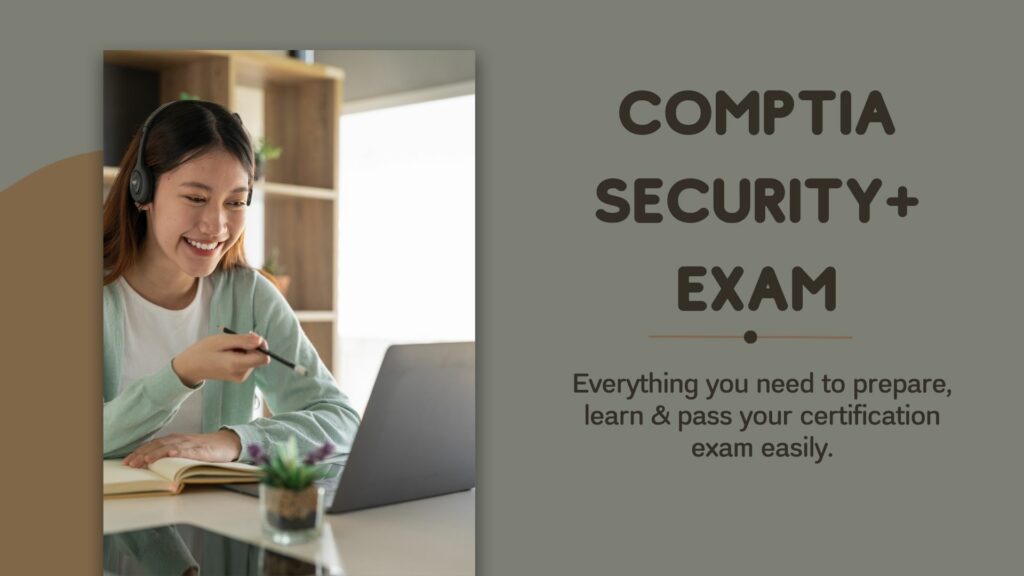Understanding the structure and content of the CompTIA Security+ Exam
Embarking on the journey to earn the CompTIA Security+ certification is a pivotal step towards establishing oneself in the realm of cybersecurity. This credential, offered by CompTIA, stands as a testament to the holder’s foundational knowledge and skills in securing applications, networks, and devices; conducting threat analysis; responding with appropriate mitigation techniques; and adhering to applicable policies, laws, and regulations. The examination itself is meticulously structured to evaluate a candidate’s proficiency across a broad spectrum of security concepts and practices.
The exam’s content is divided into several domains, each focusing on a specific area of cybersecurity. These include threats, attacks, and vulnerabilities; technologies and tools; architecture and design; identity and access management; risk management; and cryptography and PKI. This comprehensive coverage ensures that individuals are well-versed in both theoretical and practical aspects of security. The format of the exam, which consists of multiple-choice and performance-based questions, is designed to assess not only the candidate’s knowledge but also their ability to apply it in real-world scenarios. Understanding the structure and content of the exam is crucial for effective preparation and ultimately, for achieving certification.
Key resources and study materials for CompTIA Security+ preparation
Preparing for the CompTIA Security+ Exam requires a strategic approach, underpinned by a selection of key resources and study materials. The breadth and depth of topics covered necessitate a comprehensive study plan, incorporating a variety of learning tools and resources. Official study guides, available through CompTIA, offer an in-depth exploration of the exam content, structured around the core domains. These guides are invaluable for understanding the theoretical aspects of cybersecurity that candidates will be tested on.
Additionally, online courses and video tutorials provide a dynamic learning environment, catering to those who benefit from visual and auditory learning methods. Practice tests are another critical resource, enabling candidates to gauge their readiness and familiarise themselves with the exam format. Forums and study groups also offer the opportunity to engage with peers, sharing insights and clarifying doubts. A balanced utilisation of these resources, tailored to the individual’s learning style, is essential for a thorough preparation. Ultimately, the choice of study materials should align with the candidate’s personal learning preferences and the areas where they seek to deepen their understanding.

Developing a study plan tailored for CompTIA Security+ success
Developing a study plan tailored for success in the CompTIA Security+ Exam necessitates a strategic and disciplined approach. The first step involves a thorough analysis of the exam objectives, which provides a clear understanding of the topics that need to be mastered. Based on this analysis, candidates should allocate study time in a manner that reflects the weightage of each domain within the exam. It is essential to incorporate both theoretical learning and practical exercises to ensure a well-rounded preparation.
Setting realistic goals and deadlines is crucial to maintain progress and motivation. A study schedule that breaks down the syllabus into manageable segments can help in systematically covering all areas without becoming overwhelmed. Incorporating regular review sessions is also beneficial for reinforcing learned concepts and identifying areas that require further attention. Additionally, leveraging a variety of study materials, including books, online courses, and practice exams, can cater to different learning preferences and enhance understanding. Ultimately, consistency and perseverance are key. Regularly dedicating time to study, even in small increments, can significantly impact one’s readiness for the CompTIA Security+ Exam.
Practical tips for mastering CompTIA Security+ exam objectives
Mastering the objectives of the CompTIA Security+ Exam requires a blend of theoretical knowledge and practical application. A robust understanding of the exam’s core domains is fundamental; however, the ability to apply this knowledge in practical scenarios distinguishes successful candidates. Engaging with hands-on exercises and simulation tools can significantly enhance one’s grasp of complex security concepts and technologies. Setting up a home lab, for instance, provides a valuable opportunity to experiment with network configurations, security protocols, and threat mitigation strategies in a controlled environment.
Another practical tip is to actively engage with cybersecurity communities and forums. These platforms can offer insights into real-world security challenges and solutions, deepening the candidate’s understanding of how theoretical concepts are applied in practice. Additionally, utilising practice exams to test one’s knowledge under exam conditions can help in identifying strengths and weaknesses. This approach not only familiarises the candidate with the exam format but also builds confidence by simulating the pressure of the actual test environment. By combining these practical strategies with a structured study plan, candidates can effectively prepare for the CompTIA Security+ Exam, ensuring a comprehensive understanding of both the theoretical and practical aspects of cybersecurity.
Importance of hands-on experience for the CompTIA Security+
The significance of hands-on experience for aspiring CompTIA Security+ professionals cannot be overstated. While theoretical knowledge lays the foundation, it is the practical application of this knowledge that truly prepares individuals for the challenges of the cybersecurity field. Hands-on experience equips candidates with the skills necessary to navigate and resolve real-world security issues, bridging the gap between what is learnt in books and how it is applied in practice. Engaging in practical exercises, such as configuring security protocols, managing network vulnerabilities, and implementing threat mitigation strategies, fosters a deeper understanding of the subject matter.
This experiential learning approach also enhances problem-solving skills, critical thinking, and the ability to work under pressure—attributes that are invaluable in the dynamic landscape of cybersecurity. For those pursuing the CompTIA Security+ certification, incorporating practical experiences into their study regimen can significantly boost their confidence and competence. Whether through setting up a home lab, participating in cybersecurity workshops, or utilising simulation software, hands-on practice prepares candidates not just for the CompTIA Security+ Exam, but for a successful career in cybersecurity, making it an indispensable part of their preparation journey.
Utilising practice tests effectively for CompTIA Security+
Utilising practice tests effectively is a crucial strategy for those preparing for the CompTIA Security+ Exam. These tests serve not only as a means to assess knowledge and identify areas requiring further study but also as a tool to familiarise candidates with the format and time constraints of the actual examination. To maximise the benefits of practice tests, it is advisable to begin incorporating them into the study plan well ahead of the exam date. This allows for a gradual progression from learning and understanding the concepts to applying them under exam conditions.
An effective approach involves taking initial practice tests to establish a baseline, identifying strengths and weaknesses in one’s understanding of the material. Subsequent study efforts can then be tailored to address these gaps. Regularly scheduled practice exams thereafter can track improvement over time and build test-taking stamina. It is important to review the explanations for both correct and incorrect answers, as this deepens comprehension and aids in retaining information. By approaching practice tests as an integral part of the preparation process, candidates can significantly enhance their readiness for the CompTIA Security+ certification, ensuring a well-rounded grasp of both the knowledge and skills required to succeed.
Strategies for managing time and stress during the CompTIA Security+ exam
Managing time and stress effectively is paramount for those sitting the CompTIA Security+ Exam. The structured nature of the exam requires candidates to not only possess a deep understanding of the content but also to be able to demonstrate this knowledge efficiently under time constraints. One key strategy is to familiarise oneself with the exam format beforehand, allowing for a more strategic allocation of time across questions. This involves practicing with timed exams to develop a sense of pace and to identify types of questions that may require more time or are more challenging.
Another crucial aspect is the management of stress, which can significantly impact performance. Techniques such as deep breathing, mindfulness, and positive visualisation can be beneficial in maintaining calm and focus during the exam. It is also advisable to establish a routine that includes regular breaks during study sessions to prevent burnout and to ensure peak mental condition on the day of the exam. By combining effective time management strategies with stress reduction techniques, candidates can approach the CompTIA Security+ Exam with confidence, optimising their performance and enhancing their prospects for success.
Continuing education and career paths after passing CompTIA Security+
Passing the CompTIA Security+ Exam opens up a myriad of opportunities for career advancement and continuing education in the field of cybersecurity. With the certification in hand, individuals are well-positioned to explore a variety of roles, such as security analyst, security engineer, or network administrator, each offering unique challenges and the potential for professional growth. The dynamic nature of cybersecurity means that the learning journey does not end with certification. In fact, it marks the beginning of a commitment to continuous education and skill development.
Many professionals choose to further their expertise by pursuing advanced certifications or specialisations within the cybersecurity domain. Options such as the CompTIA Cybersecurity Analyst (CySA+) or Certified Information Systems Security Professional (CISSP) are popular choices for those looking to deepen their knowledge. Additionally, engaging in professional development activities, such as attending cybersecurity conferences, participating in workshops, and joining professional networks, can provide valuable insights into emerging trends and best practices. By embracing a culture of lifelong learning, individuals who have achieved the CompTIA Security+ certification can continue to evolve their skills, stay ahead of the curve in the rapidly changing cybersecurity landscape, and unlock new career opportunities.
Deduction
Deduction, a term widely recognised across various disciplines, holds a particularly significant place within the realm of cybersecurity, especially for those preparing for the CompTIA Security+ Exam. In essence, deduction is the process of reasoning from one or more statements (premises) to reach a logically certain conclusion. This analytical skill is crucial for cybersecurity professionals who must often sift through vast amounts of data to identify security threats, vulnerabilities, and the most effective measures for their mitigation. The ability to deduce the implications of certain security configurations, for instance, can mean the difference between a secure network and one susceptible to breaches.
For candidates of the CompTIA Security+, honing deductive reasoning skills is not merely an academic exercise but a practical necessity. It enables them to effectively analyse scenarios presented in the exam, drawing on their theoretical knowledge and applying it to solve complex problems. Moreover, in the ever-evolving landscape of cybersecurity, where new threats emerge with alarming regularity, the capacity for deduction allows professionals to anticipate potential security issues before they arise, implementing proactive measures to safeguard digital assets. Thus, mastering the art of deduction is not only key to excelling in the CompTIA Security+ Exam but also to thriving in a cybersecurity career.
